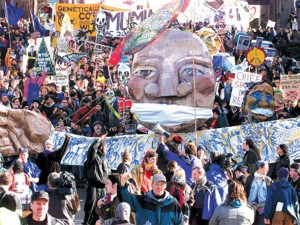 |
Peoples' movements and protests |
 |
|
MobilizationsThe republican movementThe Nordic popular movevment cultureThe Communist movementThe Islamist movementThe Global Justice MovementBack to Total movementsBack to main page
|
The movement for global justice
The global justice movement is / was a wave of movement around 2000 that was aimed at the efforts of capital and state to monetize and privatize all social relations. They consisted of a variety of local and national mobilizations that still exist, but these gained a strong global presence for a time because the government organized itself globally through organizations such as the WTO and the IMF. As these organizations have become less important, so has the global coordination of popular movements. The wave of motion was supported by three different networks. 1. The backbone was the small farmers’ trade union international Vía Campesina, which itself was formed as a resistance to free trade in food and to the patenting of life. Vía Campesina contributed with weight, pressure on their respective states and legitimacy. 2. A more volatile organization was the long-term movement that was forced out as a result of the so-called IMF uprisings, i.e the violent uprisings that followed the capitulation of governments to the IMF’s austerity demands. The most important of these organizations was the churches’ Jubilee 2000 campaign demanding the write-off of odious debts. 3. The most volatile organization was the cooperation of the youth and environmental movements Peoples’ Global Action, whose active duration lasted only a few years. However, there was a long tradition in these circles that went back to the campaigns against breast milk replacement, deforestation and dams in the 1980s and the anti-apartheid movement in the 1990s, whose contacts and networks were largely exploited, and whose networks will also be exploited in future mobilizations. When the wave of movement reached the front pages of newspapers in connection with the collapse of the WTO negotiations in Seattle in the New Year 2000, it already had a long history behind it. Four years earlier, for example, it had succeeded in stopping an international trade agreement, the MAI agreement, which would have given transnational corporations interpretive precedence over states. And powerful demonstrations against monetization / privatization at every global summit had actually been the rule since the 1980s (see full list here, pdf!). But in Seattle, the movement’s pressure on southern governments had become so strong that they also revolted against ”the Quad”, i.e the United States, the European Union, Japan and Canada. The movement wave was disorganized when open violence began to prevail in international relations, i.e when NATO occupied Iraq and Afghanistan. However, it can be said that the lasting results are a. That the Northern countries’ attempts to legislate neoliberalism were greatly weakened, b. That the Southern countries have strengthened their positions, both the economically strong South & East Asian countries and Latin America where movements 1 and 2 were unusually strong and largely coordinated by the Native American movement, and c. that the latter also applies within the popular movements themselves where southern movements are now hegemonic.
Reading
|

